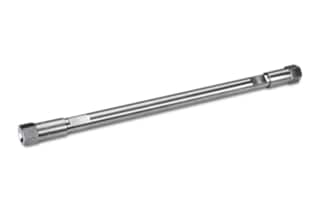
|
Chemistry |
C18 |
|
Separation Mode |
Reversed Phase |
|
Particle Substrate |
Silica |
|
pH Range Min |
2 pH |
|
pH Range Max |
8 pH |
|
Maximum Pressure |
6000 psi (415 Bar) |
|
Endcapped |
Yes |
|
Silanol Activity |
High |
|
Particle Shape |
Irregular |
|
Particle Size |
10 µm |
|
Endfitting Type |
Waters |
|
Pore Size |
125 Å |
|
Format |
Column |
|
Surface Area |
330 |
|
System |
HPLC |
|
USP Classification |
L1 |
|
Inner Diameter |
4.6 mm |
|
Length |
150 mm |
|
Carbon Load |
10 % |
|
UNSPSC |
41115709 |
|
Brand |
µBondapak |
|
Product Type |
Columns |
|
Units per Package |
1 pk |

µBondapak C18 Column, 125Å, 10 µm, 4.6 mm X 150 mm, 1/pk
µBondapak C18 columns are general purpose, silica-based, reversed-phase C18 columns that are based on 10 µm particle technology. As a starting point for preparative chromatography, no other column can provide the balance between resolution, throughput, and cost.
Waters µBondapak packing material is the only authentic µBondapak packing in the field, even though many other competitors claim to have µBondapak-like selectivity in their columns. Waters µBondapak packing columns have set a high standard for reproducible, high-performance chromatographic columns, which is hard to mimic, making them the most widely referenced and requested columns in the world.
The Waters µBondapak C18 Column is a general-purpose, reversed-phase, Silica-based C18 column with a pH range of 2 to 8 and a maximum pressure setting of 6000 psi (or 415 Bar). You can count on the Waters µBondapak C18 Column to consistently deliver excellent quality and the desired results for liquid chromatography. These columns, like all Waters equipment, are manufactured in dedicated state-of-the-art Waters facilities. All Water manufacturing plants and facilities adhere to the most stringent cGMP and ISO 9001 standards. Each step of the manufacturing process is meticulously monitored and controlled, ensuring that the equipment in your labs is of the highest quality.
Go to our website or review our collection to find products that work with your setup or to shop for lab equipment to replace your stock and expand your existing equipment portfolio as needed. If you have any questions, problems, or need help with product information and selection, please use our website to contact a member of our global client support staff.
You may also be interested in the Reversed-Phase QC Reference Material; the Quality Control Reference Materials portfolio is a unique collection of standards and mixtures. These products allow the user to evaluate and benchmark their chromatography system before the analysis of critical material. The Reversed-Phase QC Reference Material contains 7 compounds, including uracil, butyl paraben, naphthalene, propranolol, dipropyl-phthalate, acenaphthene, and amitriptyline at pH 7. This standard mix should be used to confirm the benchmark performance of your analytical HPLC or UPLC system. This particular QC Reference Material is a specially formulated mix that includes a void marker, neutral, acidic, and basic compounds.
What Is the Difference Between HPLC Columns C8 And C18?
C8 and C18 are two types of straight-chain alkyl groups used in reverse-phase HPLC chromatography for silica surface modification. An aqueous, moderately polar mobile phase is used in reverse-phase chromatography. The primary distinction between C8 and C18 columns used in HPLC is that the C8 columns' stationary phase contains octyl carbon chain (C8)-bonded silica, whereas the C18 column contains octadecyl carbon chain (C18)-bonded silica. Furthermore, C8 columns are less hydrophobic and have a lower density, whereas C18 columns are more hydrophobic and have a higher density. As a result, C8 columns have a low retention time, whereas C18 columns have a higher retention time. As a result, the C8 columns achieve lower separation, whereas the C18 columns achieve higher separation.